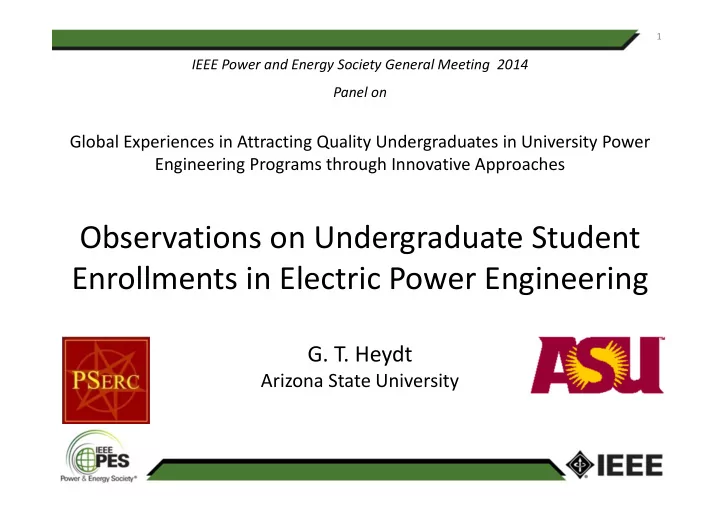

1 IEEE Power and Energy Society General Meeting 2014 Panel on Global Experiences in Attracting Quality Undergraduates in University Power Engineering Programs through Innovative Approaches Observations on Undergraduate Student Enrollments in Electric Power Engineering G. T. Heydt Arizona State University
2 This panel presentation concerns undergraduate student enrollments in electric power engineering at large universities in Canada and the United States. The focus is on what students should know before entering their first power area course, what they should learn, and how to instill enthusiasm for the subject. Experience in teaching this type of course shall be given. Some conjecture on how to attract top quality students to the field shall be given.
3 What they should know upon graduation How to be a productive power engineer capable of solving contemporary engineering problems How to remain abreast with new developments in engineering and energy policy, including continuing engineering education and professionalism Have a feeling for what is important (and what is not so important) How to communicate How to find answers to questions when the individual is unsure of the correct approach – i.e., availability of professional resources
4 Components of smart grid engineering
5 Instilling enthusiasm RENEWABLES appeal to the students who have an interest in the public good. Inclusion of actual designs in homework and project assignments is cited by students as very motivational. COMPUTER SOFTWARE appeals to students who are adept at software products. Experience with full software tools (not ‘student’ or abbreviated versions) and real system data enhances student interest. LABORATORY PROJECTS and senior (capstone) design experiences illustrate the theory, and the students who like to work with their hands are attracted to these projects. ATTENDANCE AT CONFERENCES makes student aware that they are not in a ‘cocoon’ , other students and practicing engineers are working on similar projects . Example conferences are all PES meetings (many have student programs), and NAPS. SCHOLARSHIPS often attract students. Other forms of recognition (e.g., prize papers) may also be motivational. THE IMPORTANCE AND RELEVANCE OF THE SUBJECT MAY WELL BE THE MAIN MOTIVATION TO WORK IN POWER ENGINEERING.
Bloom’s taxonomy • The lowest level is termed knowledge : this level entails memorization and duplication of existing material. This level is largely duplicative in nature and does not lend itself to innovation and new ideas. • Understanding is different from replication of standardized designs as in the lowest level. In this level, the educated engineer begins to comprehend why the standardized designs are replicated.
Bloom’s taxonomy • Application , one finds use in engineering in general, but still not allowing innovation in design. • At the analysis level, one begins to recognize cognitive capability in students to use the students’ learning for the dissection of new conditions and how to handle them in an engineering sense. • The synthesis level allows the practitioner to arrange and realize designs. It is believed that in the smart grid milieu, this is approximately the objective of the Master of Science level. • The highest level of Bloom’s taxonomy relates to the deepest level of understanding which allows one to argue and debate alternatives, to evaluate arguments, and to place solutions in engineering practice and policy. This highest level is termed evaluation.
DOCTORAL LEVEL MASTERS LEVEL BACHELORS LEVEL TECHNICIANS Bloom’s taxonomy
Some enrollment statistics Taken directly from the Task Force paper, 2006, US+Canada only, graduate + undergraduate 9
Taken directly from the Task Force paper, 10 2006, US+Canada only, graduate only
11 Taken directly from the Task Force paper, 2006, US+Canada only, graduate (upper) and graduate + undergraduate (lower)
12 Estimated replacements in 2013-14 for selected job categories US+Canada only Percentage of Estimated Estimated potential number of retirements Job category attrition and replacements only retirements Technicians 49.0 27,000 20,500 Non-nuclear plant 47.6 12,000 9,000 operators All engineers 44.7 14,500 10,000 Pipe fitters / 45.0 8,500 6,500 pipe layers Line workers 40.2 29,500 19,000
13 General remarks related to enrollments About 3000 to 4000 new BS, MS and PhD students graduate each year in the US and Canada in electric power engineering The percentages of graduates for the BS / MS / PhD degrees is about 67%, 20%, 13% The total number of engineers needed per year is in the range 10,000 to 14,500 for the two year period 2013-14. This is inclusive of manufacturers, utilities, government, non-profits, sales, software vendors, A&E firms. Canadian data are about 10% of cited US data. Estimated new power engineers needed in North America number 5500-8000 / year. Enrollments in power courses at all levels is driven by enthusiastic instructors, funded research (and concomitant student support and scholarships), applications oriented opportunities, and perception of a high level of activity at the universities.
14 Modernization of curricula Include: • Power electronics • PV resources • Wind generators of various types • Machine drives • Electronic lighting / CFLs, LEDs • Use of large scale problems in project work / professional versions of software tools • “Smart Grid” topics such as automated circuit operation, many sensors and the use of measurements for control
15 Areas integrated into a ‘smart grid’ curriculum • Direct digital control • Identification of new roles of system operators • Power system dynamics and stability • Electric power quality and concomitant signal analysis • Transmission and distribution hardware and the migration to middleware • New concepts in power system protection • Environmental and policy issues • Reliability and risk assessment • Economic analysis, energy markets, and planning
16 Summary Estimated new power engineers needed in North America number 5500- 8000 per year. About 3000 to 4000 new BS, MS and PhD students graduate each year in North America in electric power engineering. It is expected that ‘smart grid’ topics in the curriculum would encourage greater enrollments in power engineering at all levels. Enrollments in power courses at all levels is driven by enthusiastic instructors, funded research , applications oriented opportunities, and perception of a high level of activity at the universities.
17
Recommend
More recommend